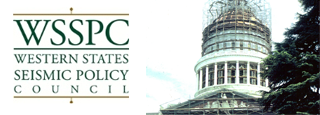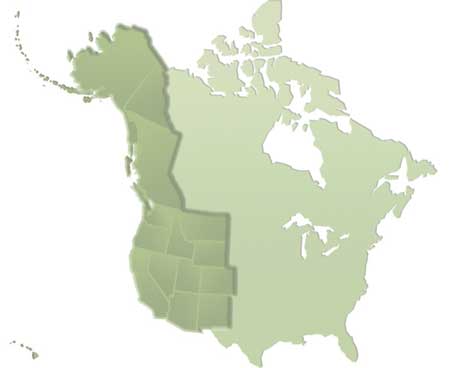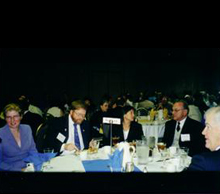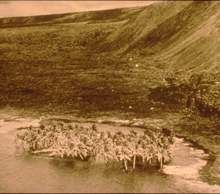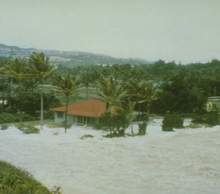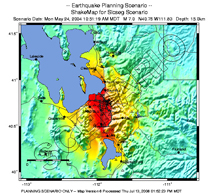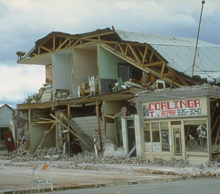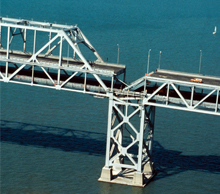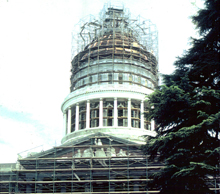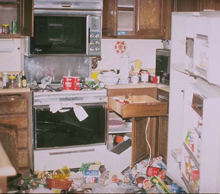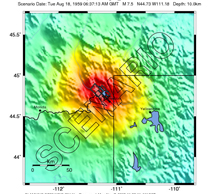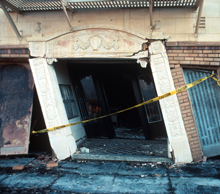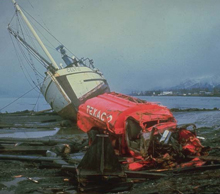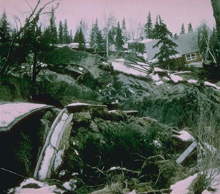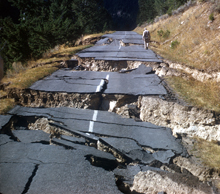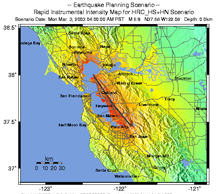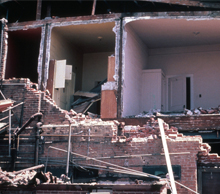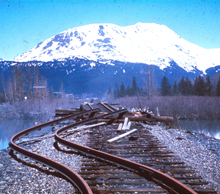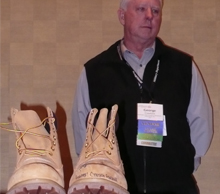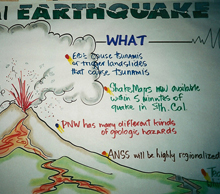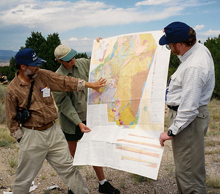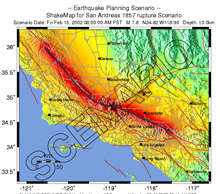Description
The 1946 Aleutian Islands earthquake occurred near the Aleutian Islands on April 1, 1946, and generated a Pacific-wide tsunami. The magnitude 8.1 earthquake caused 165 casualties. Wave heights reached an estimated 115 feet in Alaska, and averaged 30 feet in Hawaii, where the tsunami struck without warning nearly 5 hours after the earthquake.
Impact
The earthquake caused relatively little damage in Alaska, but the resulting local source tsunami destroyed Scotch Cap Lighthouse on Unimak Island. In Hawaii, the recipient of the distant source tsunami generated by the earthquake, there was extensive damage, particularly in the city of Hilo on the Big Island, which suffered approximately $300 million (adjusted to 2011 USD) in damages and lost most of its waterfront buildings. There were 165 deaths as a result of the tsunami: 159 in Hawaii, 5 in Alaska and 1 in California.
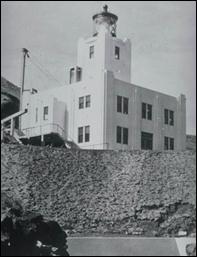 Left: The Scotch Cap Lighthouse in Unimak Island, Alaska, was built in 1940. It was five stories high, built of reinforced concrete, and stood 40 feet above the sea. On April 1, 1946, a 100-foot tsunami struck the area, completely destroying the lighthouse, and
Left: The Scotch Cap Lighthouse in Unimak Island, Alaska, was built in 1940. It was five stories high, built of reinforced concrete, and stood 40 feet above the sea. On April 1, 1946, a 100-foot tsunami struck the area, completely destroying the lighthouse, and 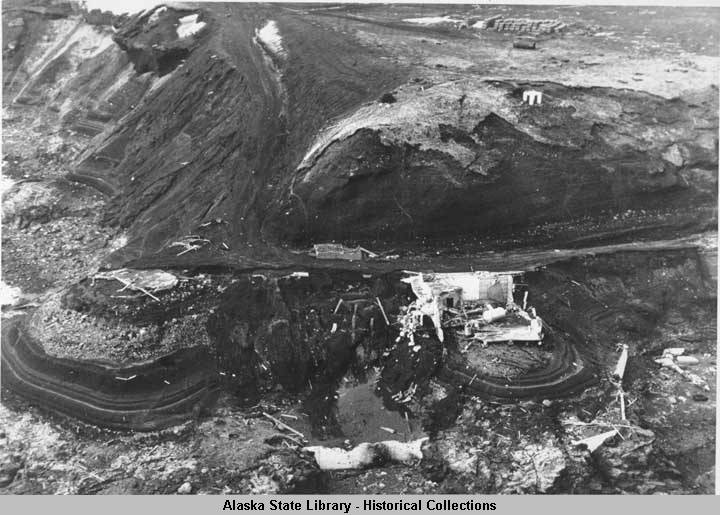 killing all five members of the lighthouse crew. This photo was taken before the tsunami. (Image: US Coast Guard)
killing all five members of the lighthouse crew. This photo was taken before the tsunami. (Image: US Coast Guard)
Right: The remains of the Scotch Cap Lighthouse and surrounding cliff area after the tsunami hit. (Image: US Coast Guard)
Lessons Learned
A tragic lesson was learned at Laupāhoehoe Point, Hawaii, where 20 students and 4 teachers drowned. The inhabitants were unfamiliar with the natural signs of a tsunami, and did not evacuate after the first wave hit. The children were on the beach gathering fish left in the wake of the previous two waves when the third, and largest, wave came in. The sole survivors, a teacher and two children, were found in the water more than 8 hours later. It had taken hours for rescue workers to find an undamaged boat to begin the search at sea.
Right: The tsunami arrived in Hilo, Hawaii, 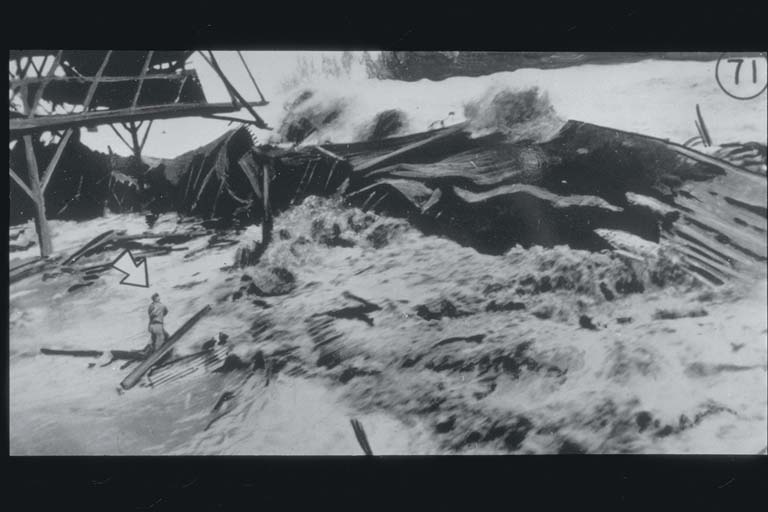 nearly five hours after the earthquake, but without warning to its inhabitants. The city’s entire waterfront was destroyed. This photo of the tsunami sweeping over the commercial pier was taken from the SS Brigham Victory. The man indicated by the arrow had just cut the line from the pier to the ship so that it could escape to open sea. He did not survive. (Original image: NOAA; arrow added)
nearly five hours after the earthquake, but without warning to its inhabitants. The city’s entire waterfront was destroyed. This photo of the tsunami sweeping over the commercial pier was taken from the SS Brigham Victory. The man indicated by the arrow had just cut the line from the pier to the ship so that it could escape to open sea. He did not survive. (Original image: NOAA; arrow added)
As a result of this disaster, the United States established the Seismic Sea Wave Warning System to provide coastal communities with warnings of approaching tsunamis. The name was later changed to the Pacific Tsunami Warning Center, and an additional location, the West Coast and Alaska Tsunami Warning Center, was added. Today, the original tsunami warning system has evolved into an international coordination effort between 26 international members, and provides early warnings to coastal communities of the Pacific and Indian Oceans.
References and Additional Resources
Damon Tucker: Hawaii News and Island Information – Survivor Story
http://damontucker.com/2009/05/11/remembering-the-hilo-tsunami-of-1946/
USC Tsunami Research Group – 1946 Aleutian Islands earthquake
http://www.usc.edu/dept/tsunamis/alaska/1946/webpages/index.html
Wikipedia – 1946 Aleutian Islands earthquake
http://en.wikipedia.org/wiki/1946_Aleutian_Islands_earthquake
Journal of Geophysical Research – Estimation of seismic moment and slip distribution of the April 1, 1946, Aleutian tsunami earthquake
http://www.agu.org/pubs/crossref/1997/97JB00274.shtml
European Geophysical Society, Natural Hazards and Earthy System Sciences: Detailed analysis of tsunami waveforms generated by the 1946 Aleutian tsunami earthquake
http://www.nat-hazards-earth-syst-sci.net/1/171/2001/nhess-1-171-2001.pdf
Tsunami Survivor Stories: Hilo, Hawaii April 1, 1946 (excerpt from the WSSPC Summer 2006 Earthquake Quarterly)
http://www.wsspc.org/wp-content/uploads/2014/04/Tsunami-Survivor-Stories_Excerpt_EQ2006Summer.pdf
